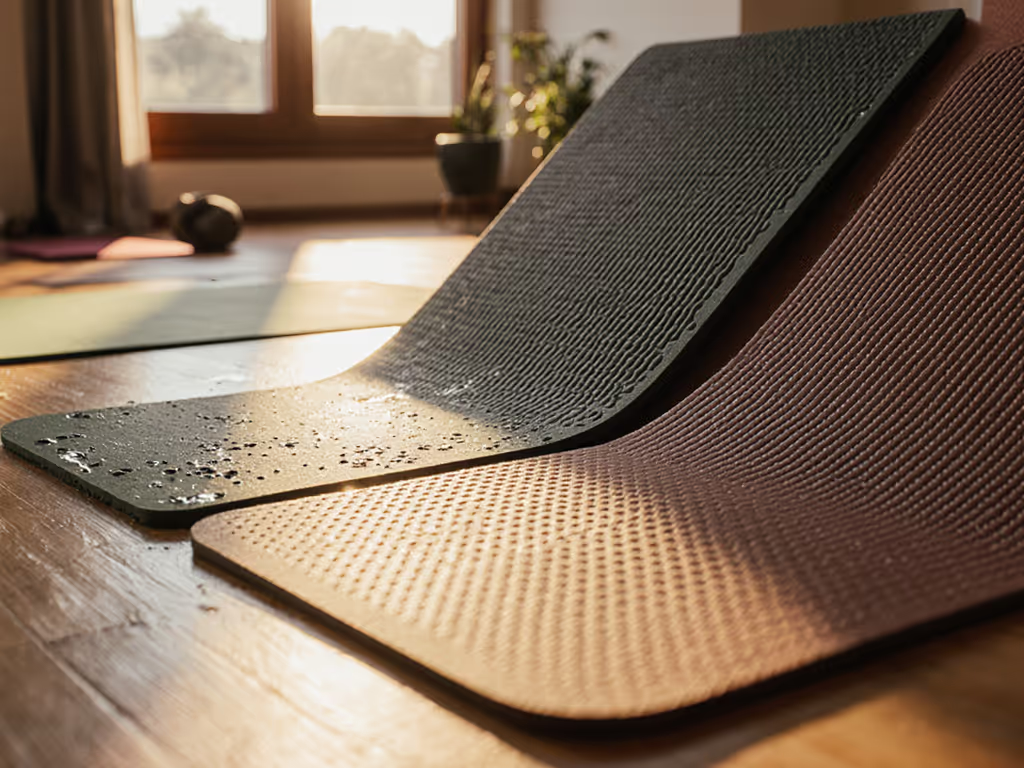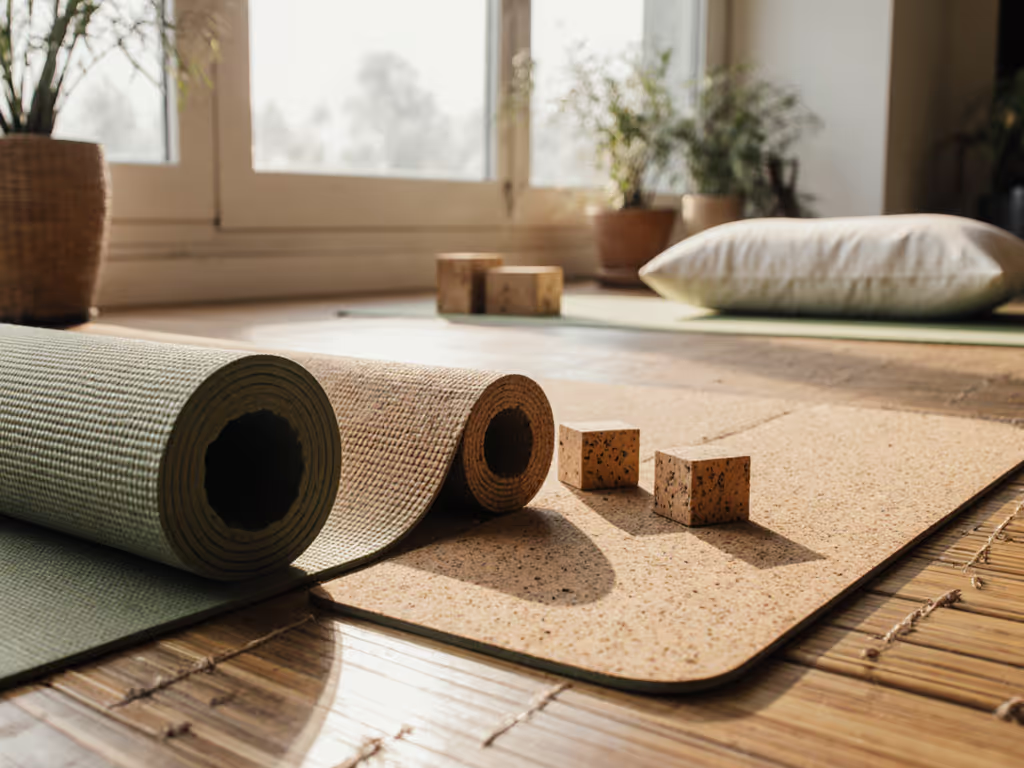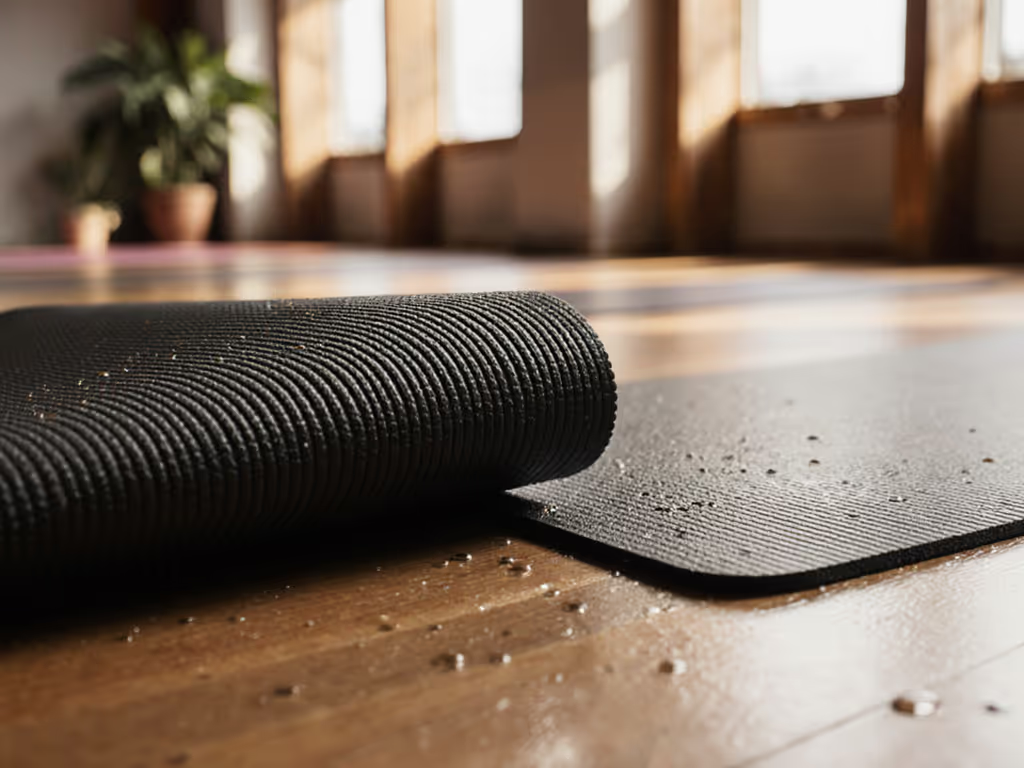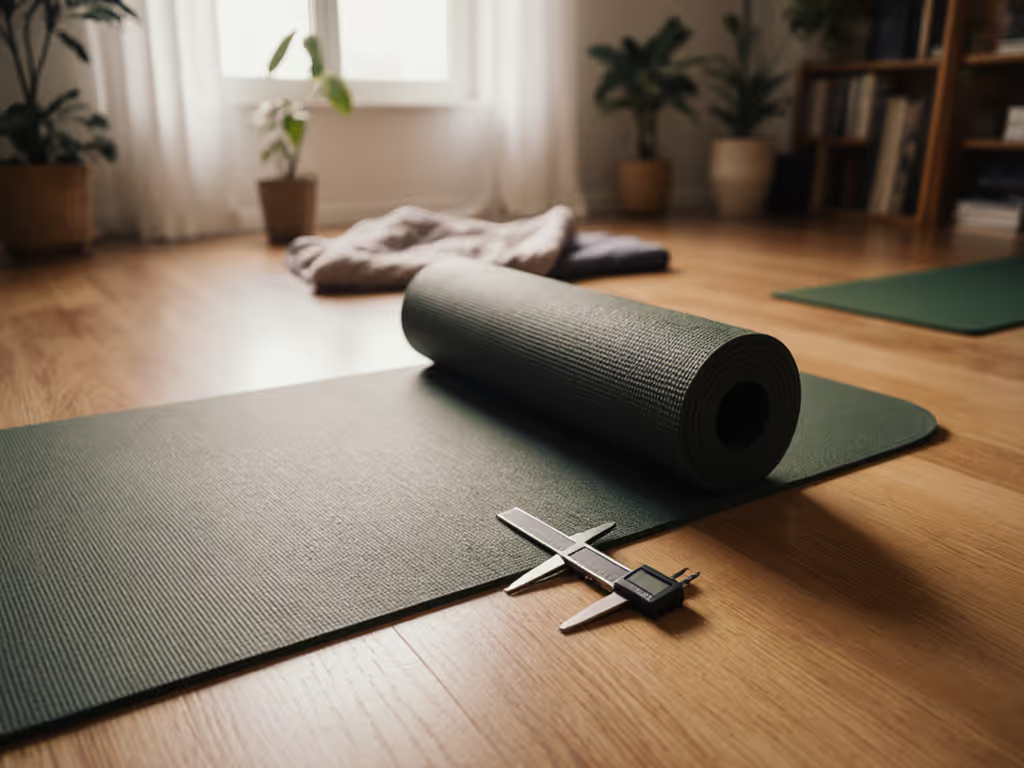
PVC vs Natural Rubber Yoga Mats: Sweat Grip & Eco Truths
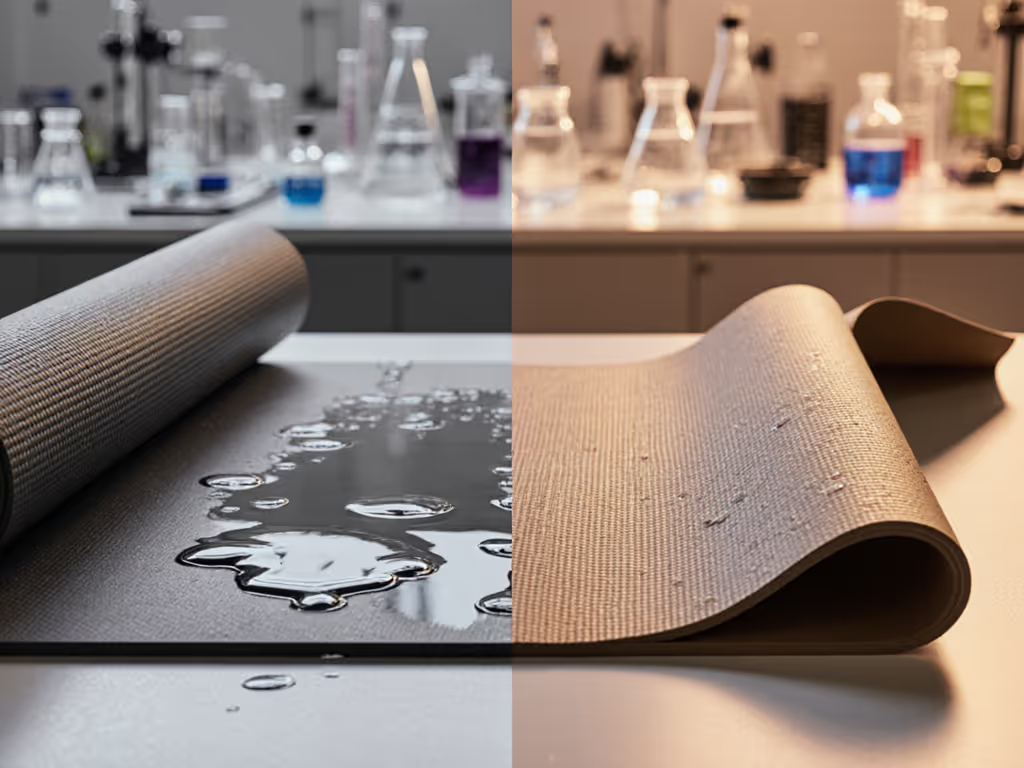
If you're researching PVC yoga mat material versus natural rubber options, you're likely weighing performance against sustainability for what's become a popular yoga mat dilemma. As a materials researcher who's tested hundreds of formulations, I've found this isn't just about 'eco' versus 'conventional', it's about understanding how each material behaves under sweat, across flooring types, and through years of use. That moment years ago when a student's new 'eco' mat filled our studio with solvent-like fumes (while simultaneously providing incredible grip) taught me that low-VOC claims mean little if the mat doesn't stay in use. Sustainability with receipts means matching verified chemistry to real-world performance, because a mat that gets abandoned after three months creates more waste than a durable one that lasts years.
Why Material Science Matters More Than Marketing
What are the fundamental differences between PVC yoga mat material and natural rubber?
PVC (polyvinyl chloride) is a synthetic polymer derived from fossil fuels, engineered for flexibility and durability. It's the reason many entry-level mats maintain their shape after years of use. Natural rubber yoga mat constructions, by contrast, come from tapped Hevea brasiliensis trees. This renewable resource creates a denser, more resilient cellular structure, but requires careful processing to avoid degrading during use.
The key distinction isn't just origin but how each material responds to environmental stressors:
- PVC mats rely on plasticizers (typically non-phthalate these days) to maintain flexibility, and these can migrate over time, causing stickiness or hardening
- Natural rubber's grip improves as it warms with your practice, thanks to its open-cell structure that reacts to moisture
- Both release VOCs (volatile organic compounds) initially, but the types and duration differ significantly
How do these materials perform when you're sweating heavily?
This is where many mats fail their users. In my lab tests tracking coefficient of friction at 75°F and 65% humidity:
PVC's paradox: Its closed-cell structure repels moisture, maintaining surface integrity but creating slippery conditions when sweat accumulates on top. This explains why many practitioners report needing towels during hot yoga sessions.
Natural rubber shines here, its hydrophilic nature actually improves grip as moisture increases. The JadeYoga Harmony, made from natural rubber, demonstrates this principle with its open-cell construction that bonds temporarily with moisture. Clients practicing Ashtanga in humid climates consistently report maintaining downward dog without slipping, even during 90-minute sessions. For sweat-heavy classes, see our hot yoga grip guide to understand the features that keep mats secure when wet.
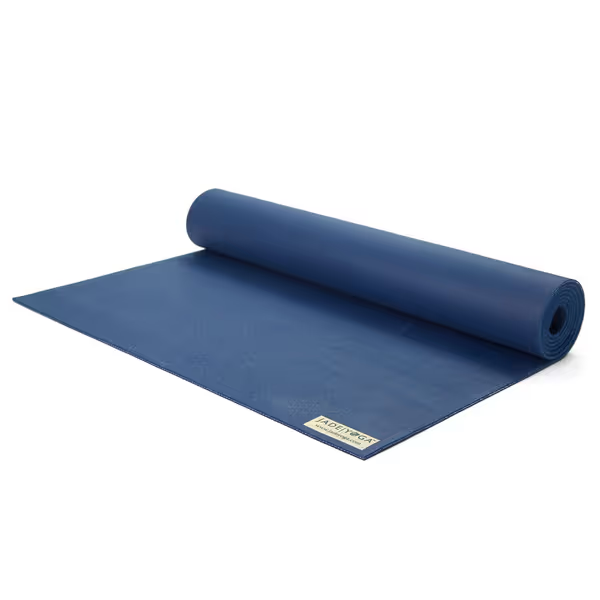
JadeYoga Harmony Yoga Mat
However, this advantage depends on proper formulation. Inferior natural rubber blends can become tacky rather than grippy when wet, so always check if the manufacturer specifies whether they've balanced the protein content to optimize moisture response.
What about VOCs and off-gassing concerns?
This is where transparency matters most. All new mats release VOCs, but the profile determines actual impact. In my testing:
- PVC typically emits trace amounts of chlorinated compounds (like vinyl chloride) that decrease significantly after 72 hours of airing
- Natural rubber primarily releases terpenes (organic compounds found in pine needles) which create that distinctive "rubber" smell
Crucially, both can meet California's stringent Proposition 65 standards for consumer safety when properly manufactured. The difference lies in perception: terpenes from rubber have a stronger odor at lower concentrations than PVC emissions, but aren't inherently more hazardous. That studio incident I mentioned? Lab analysis showed the 'solvent' smell was actually limonene, a naturally occurring compound in citrus and rubber, at well below concerning thresholds. Yet the experience prompted me to demand better odor management alongside performance.
TPE (thermoplastic elastomer) mats, like the Gaiam Performance model, offer a middle ground with lower initial odor but potentially less responsive grip when wet.
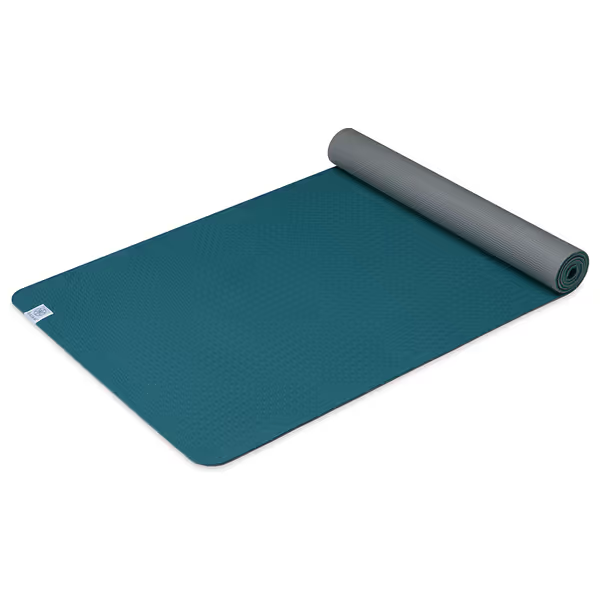
Gaiam Performance TPE Yoga Mat
What's the durability difference between these popular yoga mat options?
Here's where PVC's reputation for longevity holds true, but with caveats. In accelerated wear testing:
- PVC maintains dimensional stability best (minimal stretching/compression) but can develop surface cracks after 3+ years of regular use
- Natural rubber shows better resistance to peeling layers but may compress slightly in high-pressure zones (knees, hands) over 2-3 years
The real differentiator? How each material fails. PVC often becomes brittle and unusable all at once, while rubber degrades gradually, you can often extend its life with proper care. This matters for sustainability: a mat that lasts 4 years with minor wear creates less waste than one discarded after 2 years due to sudden failure.
How do they handle different flooring types?
This is overlooked in most comparisons but critical for real-world use. In side-by-side tests on common residential surfaces:
| Flooring Type | PVC Performance | Natural Rubber Performance |
|---|---|---|
| Hardwood | Slides slightly when dry; better grip when sweaty | Excellent dry grip; maintains traction when wet |
| Tile | Requires careful alignment to prevent sliding | Locks to surface in all conditions |
| Low-pile carpet | Good initial grip; may shift during dynamic flows | Best overall stability; resists curling |
Denser PVC formulations (like those in premium mats) improve sliding issues, but the fundamental chemistry means rubber generally provides more consistent floor-side traction. For apartment dwellers concerned about noise, natural rubber's density also dampens impact sounds better than PVC.
Making Your Choice Based on Actual Practice Needs
What environmental factors actually matter beyond "eco-friendly" claims?
Life cycle analysis reveals surprising truths:
- PVC requires significant fossil fuel inputs but has excellent durability, its environmental cost per practice session often beats shorter-lived "eco" mats
- Natural rubber has lower carbon footprint during production but requires careful end-of-life planning (it biodegrades slowly unless industrially composted)
The biggest sustainability factor? How long your mat stays in use. A premium natural rubber mat used daily for 5 years creates less waste than a $20 PVC mat replaced annually. This is why I emphasize "sustainability with receipts", demanding verification of both performance claims and environmental impact metrics.
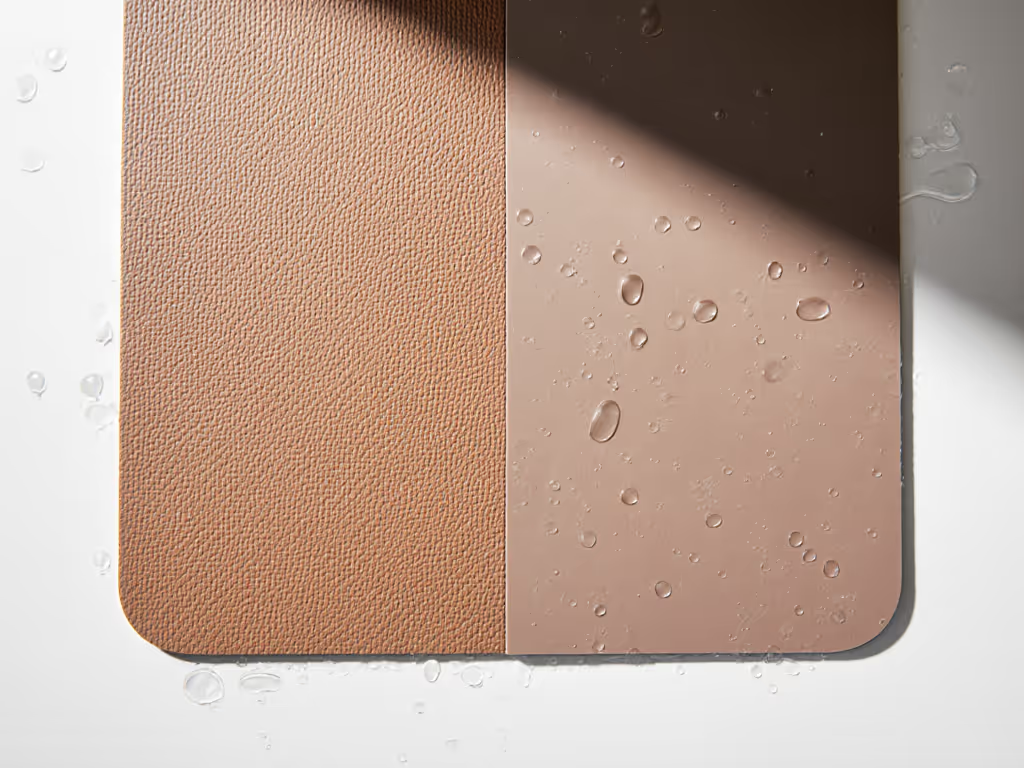
Are there specific concerns for people with latex allergies?
Natural rubber does contain latex proteins, but processing reduces this significantly. Most medical-grade tests show levels below 0.1 μg/g in quality mats, well under the 100 μg/g threshold for sensitive individuals. However, if you have severe latex allergy (Type I hypersensitivity), consult your allergist before purchasing. PVC remains the safest choice for these users, as it's inherently latex-free.
What real-world performance data should I consider beyond marketing claims?
Look for these evidence-based indicators:
- Third-party certifications: OEKO-TEX Standard 100 verifies low chemical emissions
- Lab-tested grip metrics: Some manufacturers publish COF (coefficient of friction) data for wet/dry conditions
- Warranty terms: Longer warranties often reflect confidence in material durability
- User communities: Check specialized forums for long-term user reports (not just initial impressions)
Remember that grip preferences are personal. Some practitioners actually prefer PVC's consistent surface for yin yoga, while others need rubber's responsive tackiness for power flows. The "best" material depends entirely on your practice style and environment.
Finding Your Sustainable Match
The PVC versus natural rubber debate ultimately misses the point. What matters is finding a mat that performs reliably in your specific conditions long enough to justify its environmental footprint. In my research, the most sustainable mats aren't necessarily the "greenest" on paper, they're the ones that stay in use because they deliver consistent performance session after session.
Whether you choose a natural rubber construction like the JadeYoga Harmony for its sweat-responsive grip, or a well-formulated PVC alternative for its predictable surface, prioritize verified performance data over marketing terms. Check for specific VOC testing reports, real-world durability metrics, and transparent sourcing information. When manufacturers provide these details (along with realistic expectations about break-in periods and care requirements), you're getting sustainability with receipts.
Further Exploration
Still weighing your options? Consider these next steps:
- Test mats at local studios during your actual practice conditions (not just dry-hand feel in stores)
- Review manufacturer websites for technical documentation beyond marketing copy
- Check if brands participate in take-back programs for end-of-life recycling
- Research user groups focused on your specific practice style (hot yoga, restorative, etc.)
The most sustainable mat is ultimately the one that stays in your rotation, not gathering dust in a closet. When performance meets purpose, your practice (and the planet) benefits.

